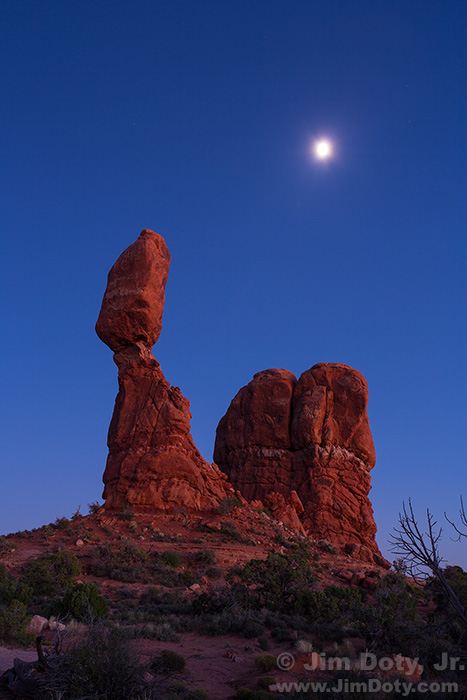In low light conditions there are colors your eyes can’t see, but your camera can capture them if you know what you are doing. That is one of the reasons I take my photography workshops and classes out on field trips at night.
My brother-in law and I were in Arches National Park a few days ago. After the sunset light faded and the show was over (at least to the uninitiated), most of the tourists went home. But 10 photographers remained (3 of therm from Australia), joyfully taking pictures far into the night, capturing the warm colors of red rock country. Like a bunch of joy-filled children, we were showing each other the wonderful colors on the backs of our digital cameras. Our eyes couldn’t see the warm red glow in the moonlight, but our cameras sure could.
The same thing happened on two evening field trips in Rocky Mountain National Park at my most recent photography workshop. In the darkness, here and there someone would say, “Oh wow, look at this!”
The reason is the “Purkinje effect”, named for the Czech scientist who discovered it in 1819. In low light conditions (like moonlight) the warm-light sensitive cones begin to shut down and no longer show us the reds, oranges and yellows that are out there. Those colors are still there, we just can’t see them. The cool light sensitive rods remain active so everything looks blue to our eyes. You can prove this to yourself by taking something red (like a red rose) out into the moonlight where there is no other light source.
Unlike our eyes, in low light conditions the camera continues to accumulate colors in long exposures, revealing all of the colors that are there.
This isn’t new of course. For decades knowledgeable photographers used slide film to capture the wonderful colors at night.
So the next time you are out late and the colors fade, set the white balance on your camera to “daylight” (if it isn’t already) and Stay Out There!
Have fun!
Photo Data: Canon 5D Mark III. Canon EF17-40mm f/4L USM lens at 40mm. 30.0 sec, f/11, ISO 100.
Links
If you don’t know how to do night and low light photography, read the relevant exposure and low light chapters in my book, Digital Photography Exposure for Dummies, one of the highest rated photography books at Amazon.com. You can learn more here and order it at Amazon.
Better than any other photograper I know of, Galen Rowell studied the phenomenon of light and the strengths and weakness of human vision and taught them to other photographers. Mountain Light is a classic example of Galen’s teaching (and it is a wonderful book). You can find it on this page.

